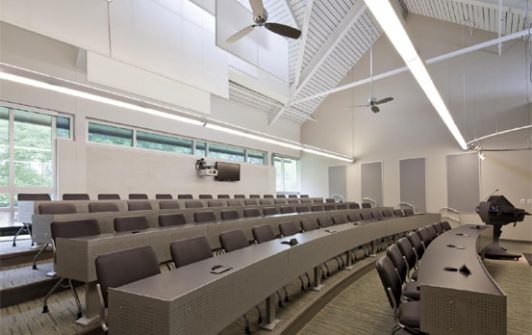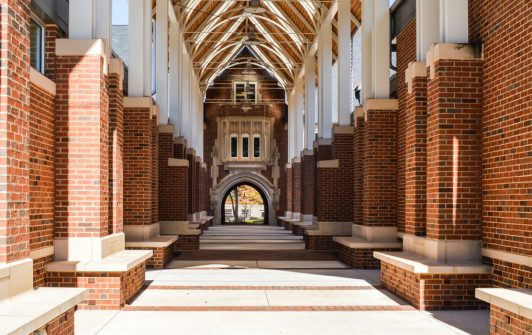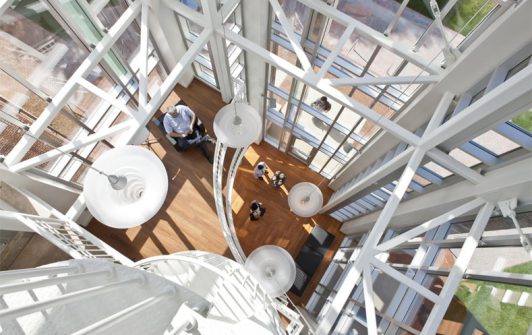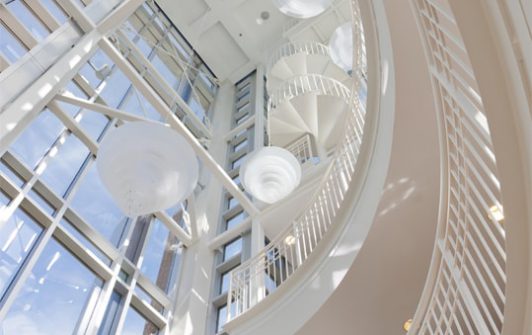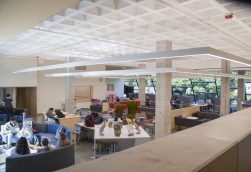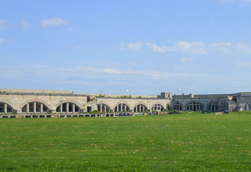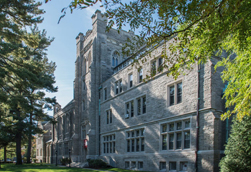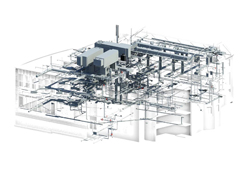Bridging the Past and Present: Reengineering a Historic Structure for a New Class of Students
Originally founded in 1828 in Lexington, GA, Columbia Theological Seminary moved to its present location in Decatur, GA in 1925. The three-story Simons-Law graduate residence hall – one of the first buildings to be constructed on the new campus – provided living space for the Presbyterian seminary’s all-male student population.
To bring the historic structure into the 21st century and make it usable for the current student population, Columbia Theological Seminary hired AHA Consulting Engineers (AHA). The firm, which has provided innovative engineering design for historic structures across the country, was equipped to handle the challenges these types of restoration projects typically present.
On paper, the plan was simple: renovate the Simons-law graduate residence hall into a student learning center, connect it to a new classroom building and make it environmentally sustainable. But the project proved to be much more complicated.
The existing structure lacked overhead space for ductwork and updated building systems. It was divided into small residences and bathrooms and required a total rework to create usable learning space. Connectivity to the new structure had to be seamless and still fit contextually, while maintaining the charm of the iconic building.
AHA’s engineers designed updates to the mechanical, electrical, plumbing and fire protection systems to meet current building codes. They devised an implementable design solution that would make the historic structure usable without detracting from its existing aesthetic.
Heating and cooling for the historic restoration and new construction project required special attention. “The existing building had plaster ceilings which lacked ceiling space and allowance for traditional air systems,” said Ryan Carter, former Partner and Director of Operations of AHA Atlanta. “So our team designed a climate-control system using high-efficiency variable refrigerant units. These units allowed for adaption in a historic building with limited space, and earned points towards the Seminary’s energy-efficiency goals for LEED certification.” And it saves money too: AHA’s system creates energy savings that enable the Seminary to operate the buildings at half the cost of similarly constructed buildings.
Throughout the energy modeling and commissioning process, AHA worked with the design team to incorporate the new systems in a way that did not detract from the overall design aesthetic. The new refrigerant units were added to the historic structure via shallow dropped ceiling shelves or wall mounts above doorways. The new addition, which has a high, pitched roof, employs a dedicated outdoor air system instead of an all-air system, which provides flexibility to distribute air as needed. However, the three-story, glass entry tower could not accommodate large ducts. AHA worked with the architect to implement natural ventilation for the tower and transition space. “The glass tower – which connects both buildings – has an abundance of glazing and faces the southeast,” explains Carter. “We were concerned about getting an adequate amount of cooling for the tower and the transition spaces. To solve this problem, we designed dropped ceilings in adjacent spaces, so air could be distributed via sidewall grills.”
To create a plumbing system that reduced the demand for the municipal water supply, AHA planned for rainwater to be collected in the basement underneath the old building for use in landscape irrigation. Since basement access in the original structure was so restricted, the plastic cistern for rainwater collection had to be disassembled and taken down to the basement in pieces and reassembled there. AHA also designed an interval pumping system which pumps out rainwater to the irrigation system.
AHA collaborated with the civil engineering design team to re-route the site drainage through a quality control feature into an underground detention structure. This structure gradually releases the water into a ravine and back into the existing watershed. In both buildings, AHA designed high-efficiency plumbing fixtures to significantly reduce overall water usage. The design also includes instantaneous water heaters instead of the traditional tank type, which continuously heat water. “These water heaters heat only the amount of water necessary for hand washing, showering or whatever is needed,” said Carter. “They don’t do any heating until water flows through them. As soon as the sink or shower is turned off, the unit shuts down.”
The end result of this engineering ingenuity is remarkable – and environmentally friendly.
And it’s a project Carter and his team of engineers continue to remember fondly. When asked about the challenges of the historic restoration project, Carter smiles and says, “Repurposing a historic building for a new modern use with updated, cutting-edge infrastructure was one of the most interesting and rewarding challenges of my career.”
Certifications
- LEED Gold NCv2.2
- Building Team Award by Building Design + Construction




